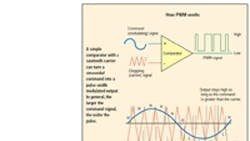Pulse-width modulation (PWM), as it applies to motor control, is a way of delivering energy through a succession of pulses rather than a continuously varying (analog) signal. By increasing or decreasing pulse width, the controller regulates energy flow to the motor shaft. The motor’s own inductance acts like a filter, storing energy during the “on” cycle while releasing it at a rate corresponding to the input or reference signal. In other words, energy flows into the load not so much the switching frequency, but at the reference frequency.
PWM is somewhat like pushing a playground-style merry-go-round. The energy of each push is stored in the inertia of the heavy platform, which accelerates gradually with harder, more frequent, or longer-lasting pushes. The riders receive the kinetic energy in a very different manner than how it’s applied.
Questions & answers
Q: What’s the main advantage?
A: Efficiency. PWM amplifiers run cooler than standard linear power amps, requiring substantially less heat sink mass. At about 90% efficiency, PWM makes electromagnetic motion feasible at power levels where hydraulics used to be the only option.
Q: What’s the downside?
A: Nature doesn’t like abrupt changes; high-current switching generates electromagnetic noise as well as voltage spikes. This calls for special measures like filtering, shielding, and the use of spike-hardened components.
Q: What’s the effect on bandwidth?
A: As a rule of thumb, the usable bandwidth of the command signal is about one decade (10X) below the switching frequency.
